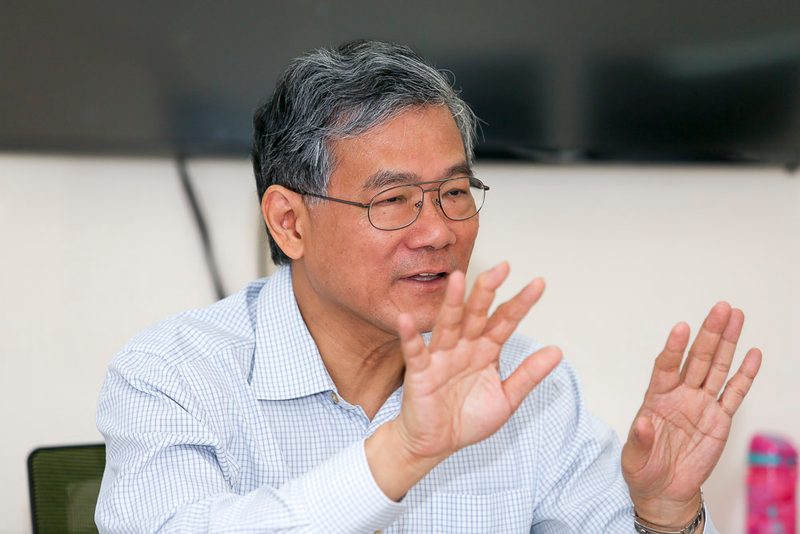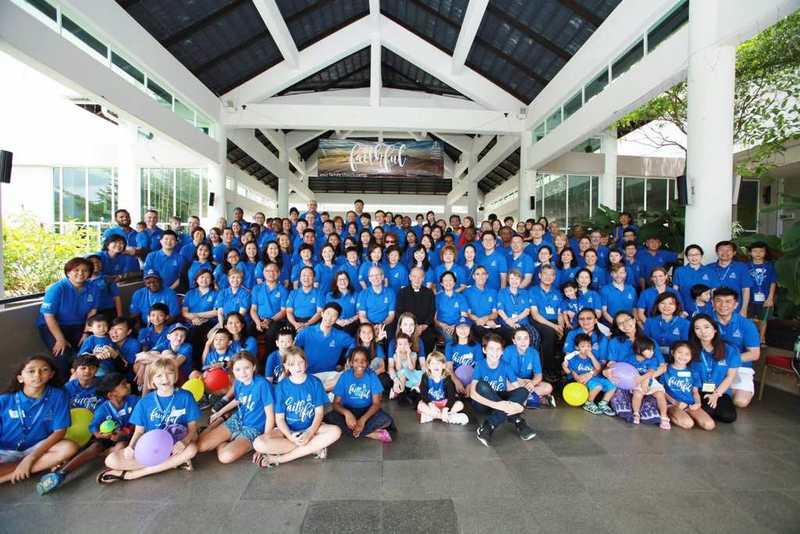KUALA LUMPUR, Sept 17 — St Andrew's Presbyterian Church, which turns 100 this year, has evolved from an expatriate-only church in colonial-era Kuala Lumpur to an international one with strong local ties.
Reverend Dr Robert Weniger, the current minister of St Andrew's who is from the US, spoke about how the international church’s multicultural community is a “strength” that allows for the cross-fertilisation of ideas from different parts of the world and an opportunity for it to live out its mission to be a “church for all nations.”
“We have to work at it sometimes, it doesn't always come easily... cultures clash sometimes, but it gives us the opportunity to try to work through and try to focus on what's really most important,” he told Malay Mail Online.
In illustrating St Andrew's inclusive approach to serve the international community in Kuala Lumpur and their different denominations, he pointed out how it is firm on core issues but allows for variety in certain Christian practices such as baptisms and communions.

For example, St Andrew's baptises both babies and adults with a sprinkling of water, but also has the option of baptising adults by immersion in water after their profession of faith.
Communion is also served in two ways — some go to the front of the church sanctuary to receive it, while church leaders will directly serve it to those who remain seated in the church pews.
"It's just that we try to respect the different traditions that people come from, so there's a richness to that. It helps us to realise that even though maybe we have some different backgrounds, maybe some different views on issues; the fact is we can all come together as brothers and sisters in Christ and focus on what's most important and worship our common Lord,” he said, calling it an “exciting and invigorating” aspect of an international church like St Andrew’s.
Church elder CJ Lim summed it up as: “So we are actually multi-cultural, multi-denominational and multi-ethnic, so it's all across the board, we are all one in Jesus Christ… in our faith, in essentials, we have unity; in non-essentials we have liberty and in everything we have charity — that's what we practise here.”

Today, St Andrew's church has a congregation of around 700 people from an estimated 25 countries, with over half of them being Malaysians and inclusive of a 100-strong Indonesian congregation. The latter, which first started meeting at the church in January 2011, has its own separate service at St Andrew’s on Sunday evenings.
A home away from home
St Andrew's was initially started in 1915 to specifically serve the UK expatriate community in Kuala Lumpur, with elder CJ Lim explaining that it was together with St Mary's Cathedral — these were the two earliest Protestant churches in the city then — respectively serving a predominantly Scottish community familiar with the Presbyterian church system and a mostly English and Welsh community as an Anglican church.
“The first trimester of the church was that of a Scottish Kirk, a house of worship built for the planters from Europe keen to maintain Presbyterian traditions from 'home',” church officials told Malay Mail Online, before church members resolved during the Japanese occupation of Malaya in the 1940s to adopt a more multiracial outlook.
There was for many years still a strong Scottish and UK identity for the church, as it was only in 1978 that it had its first non-UK minister — its 12th minister Reverend Jonathan Hoadley from the US. Since then there have also been ministers from Australia and New Zealand as well.

Kenneth Tan, who is part of St Andrew's board of managers, said the church's distinct international mix helped expatriates who had just arrived in a new country to easily find and connect with people of a similar outlook — particularly those who frequently move around due to overseas job postings.
“Sometimes you go to a new city or new country it's difficult to break into an existing group… and if you then compound it with a situation where you are not from the same country, you’ve got the situation of ‘Where are you from?’ It's a natural human reaction. It’s difficult to break in, it’s also difficult for existing groups to welcome.
“But with St Andrew's, because so many people are in and out, different to begin with, there's the commonality — it's in being different — you walk in, 'I am alright because I am different, just about everybody is different as well’... It's easier for people to walk through the doors, it's easier for people to welcome and accept,” he said. “So this ability to come together and be unified in your differences is something that makes St Andrew's special.”
While a small handful of expatriates in St Andrew's chose to stay on especially after marrying locals or if they had business locally, the rest who left the country and their descendants have continued to maintain ties with this church.
“If they are ever in town, they'll make it a point to come visit,” church elder Chin Chin Liew said.
Tan noted that this was because the church was an important part of the expatriates' lives during their brief postings of between two to five years in Malaysia.
“Ya, they come back 10, 20 years later and they will say 'Wow, we had a great time when we were here.' And sometimes they make a point of leaving behind a note to let us know that 'Wow, we are so happy this church is still around, we had such a good time when we were here, this was such a warm and welcoming home when we were living in Kuala Lumpur’.”

Church officials highlighted a farewell message penned by a former St Andrew's minister to his congregation: "It has been our joy to create in some small way a haven of rest for busy people and a happy fellowship for the lonely traveller. St Andrew's has, we hope, brought a breath of home air to many who arrived a wee bit homesick."
Even for former ministers who left and returned to the UK, they took up key roles in the Malaya Committee of the Presbyterian church leadership there, remaining firm supporters of Malaya’s Presbyterian churches and advocating for continued financial support for these churches.
Emma Christy, the great grand-daughter of St. Andrew’s second minister Reverend RD Whitehorn, was recorded visiting the church on June 25 this year.
Strong international outlook
After welcoming locals and those from other countries, St Andrew’s had in 1963 acted as a place for the local Logos Chinese-speaking congregation to meet, before further opening its doors to a small Korean congregation in 1988.
The Korean congregation has since stopped meeting at St Andrew’s and moved to its own premises, while the Logos Chinese Presbyterian Church still meets at the church on Sunday afternoons even after having expanded to 10 congregations in the Klang Valley with around 1,000 members who are mainly Malaysian Chinese, church officials said.
St Andrew’s also hosts ad hoc services for the German and Swedish community that otherwise attend their English services on Sunday mornings, typically during Christmas and when there is a visiting pastor who can conduct services in their vernacular language.

St Andrew’s membership has grown from the 65 first recorded in its inauguration communion service held on June 1914, to figures such as 90 in a December 1937 communion service.
In a 1978 letter to the Immigration Department regarding its incoming minister Rev Hoadley, St Andrew’s was recorded as having 179 members who were all English-speaking, with 91 per cent foreigners and nine per cent being Malaysians.
St Andrew’s has continued to evolve over the years, with church officials singling out the 1990s as having brought about a “dramatic change” in its make-up.

“In 1994 the membership consisted of 42 per cent Malaysians, with 58 per cent coming from other countries. By 1999 that proportion reversed, with 60.7 per cent of the members being Malaysian. In light of that change, some began to question the future of St. Andrew’s as an international church.
“As we celebrate our centenary, Malaysians still total around 60 per cent of the congregation, so the church has been able to maintain its international identity even while serving English-speaking Malaysians,” they said.

Another aspect where St Andrew’s stands out as an international church is how all its ministers have always been from abroad. Its then minister Reverend C.G. Dane was in fact in 1978 one of only two foreign ministers in local Presbyterian churches, as compared to a significantly higher number of 17 foreign ministers in such churches in 1970.
St Andrew’s had in the 1980s taken on more active roles in these churches’ national governing body Gereja Presbyterian Malaysia (GPM).
“By then the sole remaining expatriate congregation within the GPM, St Andrew’s found itself automatically taking a lead position in the EWC.
“The efforts of the EWC over some six years would ultimately lead to the formation of the English Speaking Presbytery in 1991 as an independent Presbytery under the Synod of GPM, with boundaries defined by language as opposed to traditional geography,” church officials said, referring to the English Working Committee (EWC) which reported to the GPM.
Even to this day, the Chinese-speaking Presbyterian churches in Malaysia are divided into the three geographically-defined administrative regions of Southern, Western and Northern presbyteries; while the English Speaking Presbytery now covers 25 English-speaking congregations that are not bound by geographical borders.
Local community work
A little-known fact about St Andrew's is how deeply involved it is in providing education for those living in remote areas.
"In 1974, St Andrew’s spearheaded kindergarten services for children living in plantations, who would otherwise have had no access to education. The first cohort numbered 108 children in Batang Berjuntai, and enrolment would grow to 180 children over the years, tended by some 11 teachers striving to ensure that their young charges would qualify to enter the national school system," church officials said.

They were referring to the Tadika Gembira, a kindergarten in rubber and palm oil estates which St Andrew's sponsored and supported with "volunteer services from congregation, funds, training for local teachers and supervisors".
It started off in August 1974 with three teachers and three morning classes, before eventually having a 180-strong student population by 1994.
“The church actually engaged an assistant minister, Reverend Robert Chelladurai, to spearhead this service to children who would otherwise have no access to education. The kindergarten wasn’t limited to Indian families, but Tamil-speaking children turned out to be the largest constituency. St Andrew’s was obliged to close Tadika Gembira in 2004,” church officials said.
An early record can be seen in the November 2, 1986 Order of Service, where St Andrew's informed its congregation that the church had used about RM32,500 in rental collections of church facilities to “heavily subsidise” five kindergartens and one associated playcentre at rubber estates near Selangor's Batang Berjuntai (now Bestari Jaya).

Despite being an international church, St Andrew's has continued on its decades of local community work, including as of last year supporting local schools for refugee children here, working with Christian drug rehabilitation centre Green Pastures, and social work to help the Orang Asli community.
Examples of past community work by St Andrew's include those recorded by its 13th minister Reverend Donald Elley in 1994, such as support of work involving Vietnamese refugees, outreach to young people in the Bukit Bintang area, as well as allowing Alcoholics Anonymous to meet in its church buildings.
"In a real sense we are a city Church and our Mission (our ministries) like our membership and giftedness keeps ebbing and flowing,” Rev Elley had written then.
To read more about how St Andrew's grew together with the nation and its history, click here.
To read about the unique and vital role played by the women of St Andrew's, click here. 



















